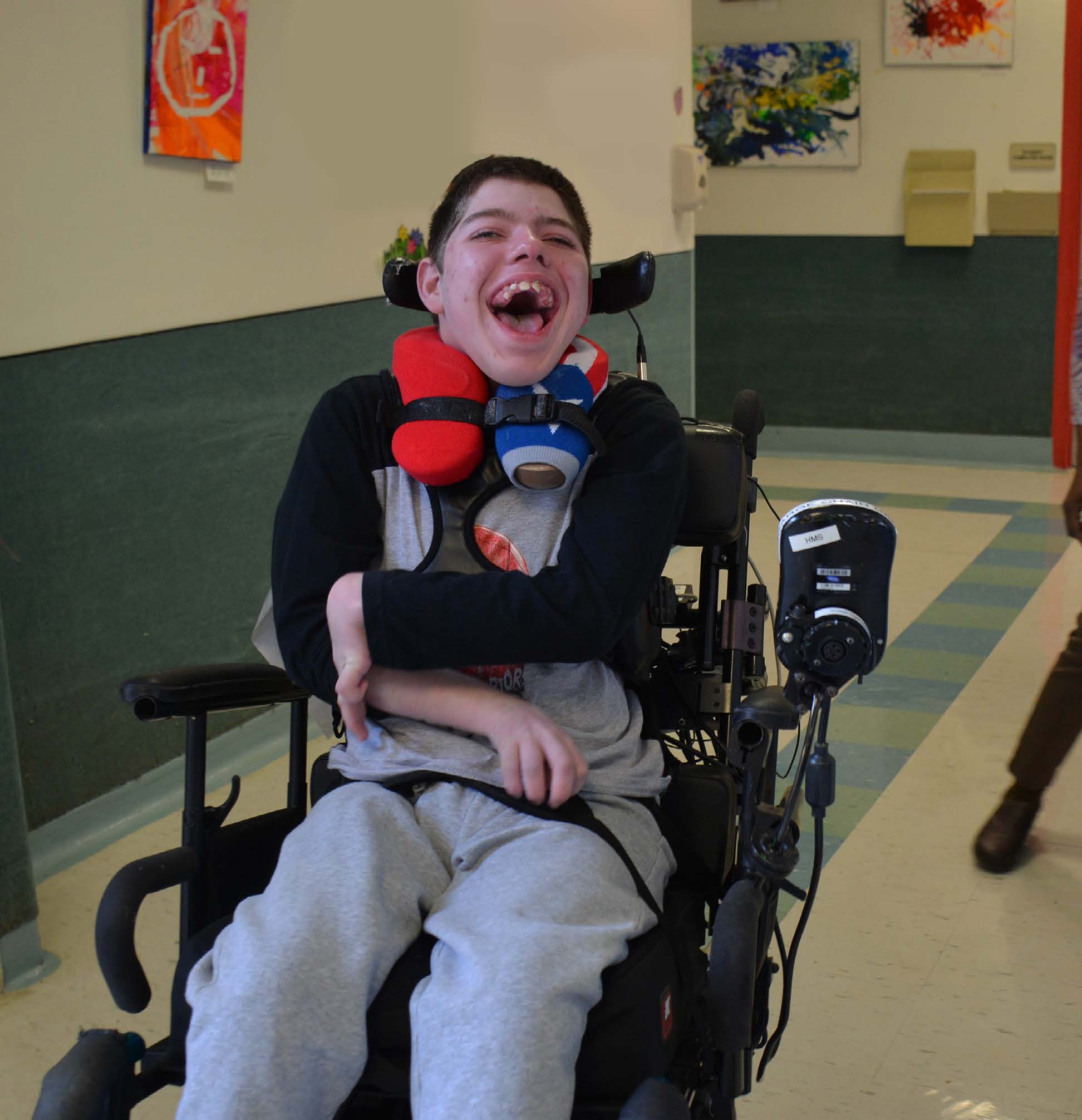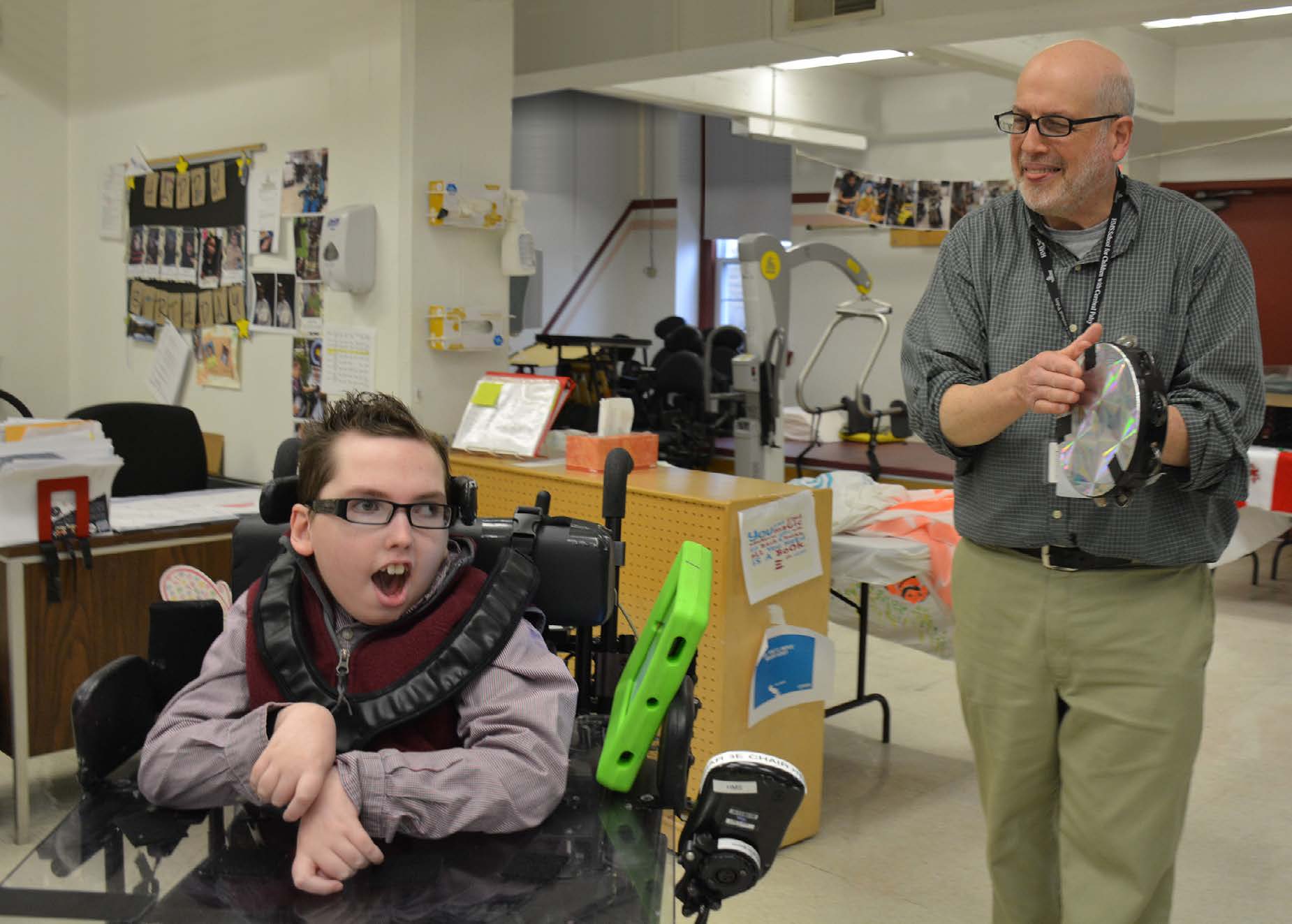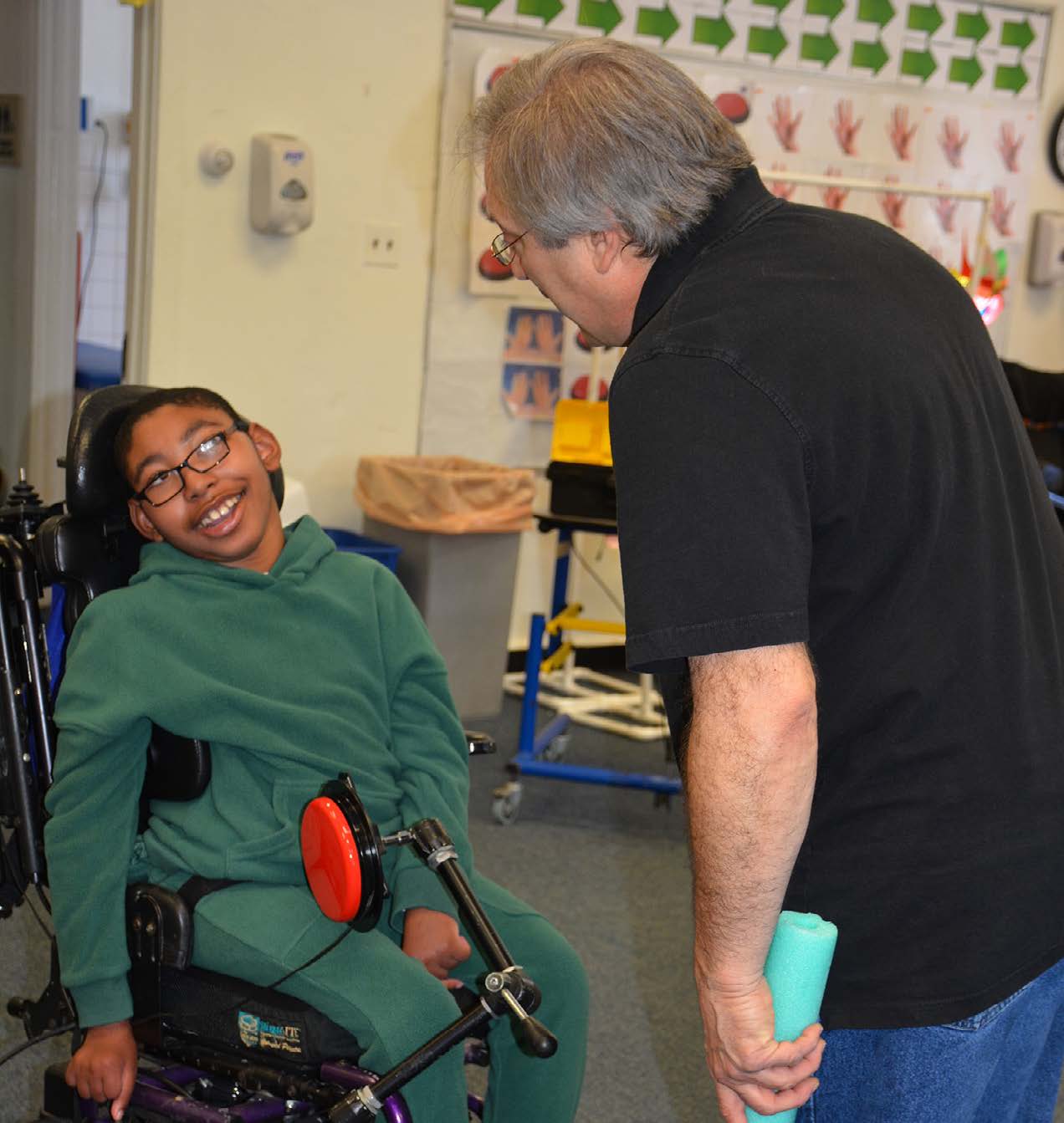
Eddie Verratti loves movement. A student at HMS School for Children with Cerebral Palsy in Philadelphia, the 14-year-old has very limited ability to move his body and would not be a typical candidate to use a power wheelchair. Yet on a recent day, Eddie was lifted and secured into a specially-outfitted power wheelchair, and, using his head to access a switch on the chair's headpiece, drove the chair to deliver a package from his classroom to a nearby room.
BY RACHEL EZEKIEL-FISHBEIN
HMS tries to give every student the experience of moving in a power chair. According to physical therapist Kate Paul, finding the optimal way for a child to access their environment in this way requires the expertise of a holistic team that can include a special education teacher, occupational therapist, physical therapist, speech therapist and assistive technologist.
DRIVER'S LICENSE: Eddie is participating in HMS's Driving to Learn program, which draws upon the research of Lisbeth Nilsson, Ph.D., OT. Occupational Therapist Janice Barbour credits the program for increased alertness, wakefulness, exploratory behavior, attention regulation, problem-solving, motivation, body awareness and sense of self among students like Eddie.
"Usually he can't sit up straight, but in the power chair, he holds himself upright, including holding his head up. Being in the chair taught him how to understand commands like stop and go—commands he wouldn't normally hear because he doesn't need to. He sits and listens for his teachers to tell him it's okay to go, and then when they tell him to stop, he laughs hysterically and often doesn't listen, because he's testing his limits. It has been an amazing experience for him."
Eddie Verratti is participating in HMS's Driving to Learn program, which draws upon the pioneering research of Lisbeth Nilsson, Ph.D., OT, at Lund University in Sweden.
About 17 million people in the world have cerebral palsy; their degrees of disability vary widely, meaning some can walk and others use a wheelchair for mobility. Of those who use a wheelchair, not all have the capacity to learn to drive a power wheelchair. Eddie Verratti's school serves students with significant disabilities and thus, all of its students use a wheelchair for mobility. Close to half already drive a power wheelchair or are learning to drive one, typically with varied means of accessing controls. For other students, the Driving to Learn program holds promise for developmental benefits.
Driving to Learn is intended for students who are not necessarily candidates for power wheelchair driving. In fact, accepting that the program's objective is not to turn their child into a power driver can be very difficult for parents. Rather, Driving to Learn uses the learning process to build important skills many children at earlier stages of development lack, such as tool use, communication, and understanding cause and effect.
For children without disabilities, learning to move during infancy is an earth-shattering experience in all of the best ways. Children gain agency as they learn their body can move and that they can control where their body is in space and access what they want through movement. Infants develop understanding of the dynamics of movement and space, and begin building independence as they realize they can purposefully move closer to a beloved parent or pet, or to reach a toy. As their movement becomes more competent and self-directed, infants acquire new language connected to that movement; words like here, there, come, stop, near, that and far gain meaning. One way children with cerebral palsy who cannot walk typically gain these skills is by learning to drive a wheelchair. This can be an issue for some students at HMS, as the school serves students from across the U.S. with complex disabilities, including those with the most severe forms of cerebral palsy.
These students are usually pushed by a teacher, therapist, family member, nurse or aide in their chairs, and lack the opportunity to learn goal-directed movement. Like the individuals in Nilsson's groundbreaking research, these students need extensive support in their activities of daily living.
It was this passivity and dependency that drew Nilsson to consider whether individuals with significant cognitive disabilities might possess untapped and undeveloped potential that could be unlocked through the actual learning process… and form the Driving to Learn project.
Driving to Learn is a slow process, measured over the course of years, not months, and through much repetition. Nilsson broke down the process into eight levels:
- 1. New activity, not aware of possible effects
- 2.Beginning of understanding of possible effects
- 3.Control of basic effect, onset of movement
- 4. Exploration of effects, direction and speed
- 5. Experimentation to find a pattern for steering
- 6.Control of steering, but coarse and unsafe
- 7. Smooth control of direction and speed, safe 8.Navigate in different milieus to do other things

POP GOES THE BUBBLE WRAP: Abel Tyson loves the sound of bubble wrap popping, so his special education teacher, Chris Stern, places bubble wrap on the ground so that every time he moves his chair, he'll hear the popping. The team motivates students with a range of sensory experiences, based on what the individual student enjoys.
At the end of the process, the individual, while still unable to safely drive independently, has learned significant other skills that support their independence. "Some of our students start out very passive," says HMS special education teacher Chris Stern. "They're used to being moved from one location to another in their wheelchairs and having everything done for them. Part of my job as a teacher is to help them learn they can more actively interact with their environment – that they're not just a passive receiver. There is intrinsic value in understanding this: it increases their sense of self-worth and self-esteem.
For the past two years, Stern has employed Driving to Learn with Raymond Franklin, who, like Verratti has multiple physical disabilities. Raymond has a moderate hearing impairment. Even so, he loves music! Stern has used the power chair and music – rather than words – to motivate Raymond to activate a switch and move. Doing this repeatedly has taught Raymond cause and effect: when he pushes the switch, he feels something – his body moving through space. Raymond can now use headrest switches to turn himself to the left or the right and to spin the chair around. His delight in selfdirected movement is obvious, according to Stern.
"We've added music close to Raymond's ear through a wireless speaker to increase his motivation and he likes to move to the music," says Stern. "In a way, he's dancing. He can't move his body in other ways, so he's using the power chair to not only understand what the switch can do, but to dance and express himself through movement. It's nice to see him really engaged and responding to an activity." Recently, the school has seen the biggest payoff. Now that Raymond can reliably initiate a cause and effect relationship and has the ability to make things happen by moving himself through space, his interest in interacting with the world around him has increased, and he has the potential to participate more fully in his life beyond school.

FOLLOW THE LEADER: Special education teacher Ed Contaldi created an opportunity for his student Amir to form an action goal in which he anticipated the effect of his movement by encouraging him to actively pursue him in space.
"Driving to Learn helps our students learn to use tools, such as switches, more effectively to access their environments, which is in part what Eddie and Raymond have been working on," explains HMS physical therapist Kate Paul. "They haven't become independent drivers, but they have become more proficient at using tools. The switch is their tool to be able to access the wheelchair. This has made them better in general at using a switch, which is a critical skill for all of our kids here. It contributes to their quality of life by giving them some element of control and a chance to actively engage." Students at HMS use switches for their communication devices, allowing them to engage in conversation, and for some students, control devices in their environment and how they spend their time. Students who are less skilled with tool use can often use a switch to turn on and off music or a television or a light, and to turn the pages in a computerized book.
Nilsson drew upon research suggesting the inability to master a switch and other tools might be the result of learned helplessness. In other words, individuals with severe cognitive impairments might lose motivation in the learning process because they had no expectation of exerting control over their world. Like HMS, Nilsson was motivated to push boundaries to help individuals with complex disabilities fulfill their potential.
Nilsson suggested that the assumption that individuals with complex disabilities had reached their "ceiling or plateau" was creating a false barrier to the development of their potential to be active and engaged. In her thesis, she wrote: "People with profound cognitive disabilities... are given few opportunities to take part in activities that are creating meaning and motivation. To become doers they are totally reliant on others' belief in their veiled potential to be active and develop consciousness… How can we assist people to experience activity and develop consciousness?"
"Driving to Learn enables our students to move and direct their movement, and it's a way for us to give them immediate multisensory, full body responses to their action," says HMS occupational therapist Janice Barbour "Teaching a student to use a switch is more abstract. When they're in the wheelchair and they hit a switch and the chair moves, boom! They take in more information than with typical switch activities: they experience movement, their view changes, sound changes, and they can understand their place in the environment. This can be very motivating for students, because they typically can't move themselves through space this way."
HMS tries to give every student the experience of moving in a power chair. According to physical therapist Kate Paul, finding the optimal way for a child to access their environment in this way requires the expertise of a holistic team that can include a special education teacher, occupational therapist, physical therapist, speech therapist and assistive technologist.
Nilsson relied solely upon a joystick for her project; however, HMS individualizes the input and where it is placed to meet each student's needs, often using a switch rather than a joystick. Many different wheelchairs from a range of manufacturers are mocked up to meet individual HMS students' needs. When a student begins with no concept of cause and effect, the switch is placed where the student's typical movements will cause them to accidentally hit it and cause movement. This reinforces that their action caused the movement.
Once the student begins to understand how the switch works, the team helps them target the switch purposefully. The team motivates students with a range of sensory experiences, based on what the individual student enjoys. If a student loves music, their favorite song might be queued up. Then the teacher will move the music away from the student and encourage the student to move toward the music. The same can be done with a favorite toy. Abel Tyson loves the sound of bubble wrap popping, so the team placed bubble wrap on the ground, so that every time he moved the chair, he'd hear the popping.
"The motivation impacts our students' understanding of their own capacity," explains Barbour. "Our students are very physically limited and sometimes they don't have a sense of the impact they can have on their environment. We're giving them a sense of agency and motivation to be able to move and engage in their environment."
Like Raymond, his school-mate Nicky Vargas, 19, is increasing his ability to interact with the environment around him through Driving to Learn and continues to expand his tool use to gain more control over his environment.
"My goal for Nicky is the most independence possible," says Jeanine Krautheim, Vargas' mother. "It was very helpful for him to see he could move himself, even if it's not all the time. He learned he could make things happen. Now he pushes a big button on the elevator in our building to make us go up and down. Being able to move and make himself move gives him a sense of freedom." "Driving to Learn opens up a whole new world of language for our students," says special education teacher Ed Contaldi. "It presents the students with the idea that they're in a space with someone else and the person can be in different points in that space. Because they haven't had the typical developmental experiences, implicit understanding that someone is far away from them has been missing until now. The concepts of 'here' and 'there' and 'near' and 'far' and acting on them and having to process them are foreign to our students. Driving to Learn gives students the experience of processing, acting upon and conceptualizing positional words."
Contaldi used Driving to Learn with Amir, 12. After a period of hand-over-hand instruction to show Amir how to use a switch, Contaldi began using language to encourage Amir to generate the movement on his own.
Contaldi would bring Amir into the hallway outside their classroom and say: "Amir, now you're in the chair that you can move on your own. You can use a switch to make it go. I'm with you now. I'm near you. Now I'm going to move far away from you. Now I'm moving back. Now I'm far away from you. I'm over here. Do you want to come here and play with me? You're over there. If you hit the switch, you can move your chair and come over here to me."
By encouraging Amir to actively pursue him in space, Contaldi created an opportunity for the student to form an action goal in which he anticipated the effect of his movement—a building block to self-awareness. For typically-developing children, this is realized in infancy as they make the transition to self-directed movement and purposeful action through play, exploration and interaction. According to Nilsson: "The experiences from the Driving to Learn project were evidence that people with profound cognitive disabilities, with the assistance of others, were capable of developing unexpected levels of tool use… Motivation provided joyfulness, belief in possibilities, positive expectations and eagerness to act and respond…With motivation, the person did engage with the learning... While they grew more self-aware or became in control of new effects, they displayed signs of well-being, such as smiles, laughter and decrease of challenging behaviors."
Barbour concurs with Nilsson's findings, crediting Driving to Learn for attributing increased alertness, wakefulness, exploratory behavior, attention regulation, problem-solving, motivation, body awareness and sense of self among those students in this program.•
ABOUT THE AUTHOR: Rachel Ezekiel-Fishbein is a Philadelphia PR consultant and writer, who teaches in Temple University's Klein College of Media & Communications. A mother of three, Rachel became an advocate for people with special needs after her son's diagnosis with Tourette Syndrome. Read a recent blog post she and her son wrote together.